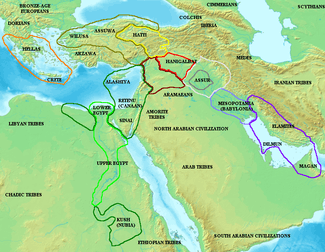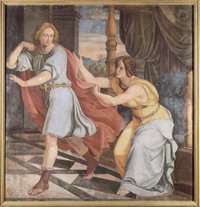Joseph and His Brothers
 Cover of the first edition of part 4 (1943) | |
| Author | Thomas Mann |
|---|---|
| Original title | Joseph und seine Brüder |
| Country | Germany |
Publication date | 1943 |
| Media type | Book |
Joseph and His Brothers (Joseph und seine Brüder) is a four-part novel by Thomas Mann, written over the course of 16 years. Mann retells the familiar stories of Genesis, from Jacob to Joseph (chapters 27–50), setting it in the historical context of the Amarna Period. Mann considered it his greatest work.
The tetralogy consists of:
- The Stories of Jacob (written December 1926 to October 1930, Genesis 27–36)
- Young Joseph (written January 1931 to June 1932, Genesis 37)
- Joseph in Egypt (written July 1932 to 23 August 1936, Genesis 38–39)
- Joseph the Provider (written 10 August 1940 to 4. January 1943, Genesis 40–50)
Themes
Mann's presentation of the Ancient Orient and the origins of Judaism is influenced by Alfred Jeremias' 1904 Das Alte Testament im Lichte des Alten Orients, emphasizing Babylonian influence in the editing of Genesis, and by the work of Dmitry Merezhkovsky.

Mann sets the story in the 14th century BC and makes Akhenaten the pharaoh who appoints Joseph his vice-regent. Joseph is aged 28 at the ascension of Akhenaten, which would mean he was born about 1380 BC in standard Egyptian chronology, and Jacob in the mid-1420s BC. Other contemporary rulers mentioned include Tushratta and Suppiluliuma.
A dominant topic of the novel is Mann's exploration of the status of mythology and his presentation of the Late Bronze Age mindset with regard to mythical truths and the emergence of monotheism. Events of the story of Genesis are frequently associated and identified with other mythic topics.
Central is the notion of underworld and the mythical descent to the underworld. Jacob's sojourn in Mesopotamia (hiding from the wrath of Esau) is paralleled with Joseph's life in Egypt (exiled by the jealousy of his brothers), and on a smaller scale his captivity in the well; they are further identified with the "hellraid" of Inanna-Ishtar-Demeter, the Mesopotamian Tammuz myth, the Jewish Babylonian captivity as well as the Harrowing of Hell of Jesus Christ.
Abraham is repeatedly presented as the man who "discovered God" (a Hanif, or discoverer of monotheism). Jacob as Abraham's heir is charged with further elaborating this discovery. Joseph is surprised to find Akhenaten on the same path (although Akhenaten is not the "right person" for the path), and Joseph's success with the pharaoh is largely due to the latter's sympathy for "Abrahamic" theology. Such a connection of (proto-)Judaism and Atenism had been suggested before Mann, most notably by Sigmund Freud in his Moses and Monotheism, which had appeared in 1939, just before Mann began work on the tetralogy's fourth part—although in the last installment of Mann's work, Akhenaten is postulated as the Pharaoh of the Exodus contemporary of Moses, while Mann in his novella "Das Gesetz" (1944) casts Ramesses II in that role.
As Joseph is saved from the well and sold to Egypt, he adopts a new name, Osarseph, replacing the Yo- element with a reference to Osiris to indicate that he is now in the underworld. This change of name to account for changing circumstances encourages Amenhotep to change his own name to Akhenaten.
The tetralogy closes with a detailed account of Jacob's famous Blessing of his sons and their tribes, his death and the funeral. The characters of the individual brothers are determined by epithets taken from the text of the Blessing of Jacob throughout the details; thus Reuben is "turbulent as the waters" (and associated with Aquarius by Jacob). Simeon and Levi are known as the "twins" (and associated with Gemini), even though they are a year apart, and portrayed as violent bullies. Juda is a lion (Leo), and inherits Abraham's blessing since Jacob disrobes his elder brothers of their birthright. Zebulun shows predilection for Phoenicians and seafaring. Jacob calls "bony" Issachar a donkey to evoke Asellus, γ and δ of Cancer. Dan is sharp-witted and "suited as a judge" (Libra). Asher is fond of dainties. Joseph is blessed by Jacob in his dual aspect of male (Dumuzi, god of seed and harvest), with reference to Taurus, and female (since for Jacob, his beloved Rachel lives on in Joseph, and in his affinity with the nourishing Earth), with reference to Virgo. As Jacob comes to Benjamin, his strength is almost gone, and with his last breath he rather incoherently compares his youngest son with a wolf, partly because of Lupus in Scorpio.
Three famous events
In the plot of the novel, the author describes the three events depicted by famous painters throughout the course of the recent centuries, namely (i) Jacob, blessing Joseph's second son, as he himself had been blessed by his father Isaac instead of his twin brother Esau; (ii) the event where Joseph is sold by his brothers (to Arabian merchants, going to Egypt), and (iii) the moment where the wife of the highest Egyptian custodian to the Pharaoh (see Potiphar's wife) is trying to seduce Joseph, and he flees leaving his cloak. These three events are painted in the following gallery:
 Jacob blessing Joseph's second son first. Rembrandt, 1656
Jacob blessing Joseph's second son first. Rembrandt, 1656 F. Overbeck, 1816/17: Joseph is sold by his brothers.
F. Overbeck, 1816/17: Joseph is sold by his brothers. Philipp Veit, 1816/17: Joseph fleeing from Potiphar's wife.
Philipp Veit, 1816/17: Joseph fleeing from Potiphar's wife.
A twentieth-century painting Joseph Accused (1971), depicting Joseph confronted by Potiphar and his wife, by Richard Rappaport is one of a set of three works including Joseph in the Pit and Jacob in Mourning which were inspired by the artist's reading Mann's Joseph and His Brothers and can be found in Rappaport's Wikipedia article with an iconographic explanation of its symbolism pointing to Mann's underlining theme: "Stranger in a Strange Land" referring to the growing anti-Semitism in Germany during the rise of National Socialism in the contemporary period when Mann was writing it.
Editions
- Die Geschichten Jaakobs. S. Fischer Verlag, Frankfurt am Main. ISBN 3-596-29435-5
- Der junge Joseph. S. Fischer Verlag, Frankfurt am Main. ISBN 3-10-048230-1
- Joseph in Ägypten. S. Fischer Verlag, Frankfurt am Main. ISBN 3-10-048232-8
- Joseph der Ernährer. S. Fischer Verlag, Frankfurt am Main. ISBN 3-10-048233-6
English translations:
- Translated by H. T. Lowe-Porter. New York: Alfred A. Knopf, 1948. ISBN 0-394-43132-4.
- Translated by John E. Woods. New York: Alfred A. Knopf, 2005. ISBN 1-4000-4001-9.
Finnish translation:
- Translated by Lauri Hirvensalo. Helsinki/Porvoo: WSOY, 1947.
Spanish translation:
- Translated by Jose Maria Souviron and Hernán del Solar. Santiago de Chile: Editorial Ercilla. 2 Vol, 1962.
Dutch translation:
- Translated by Thijs Pollmann. Uitgeverij Wereldbibliotheek, Amsterdam, 2014. ISBN 9789028424005.
Literature
- Jan Assmann: Thomas Mann und Ägypten. Mythos und Monotheismus in den Josephsromanen. C. H. Beck Verlag, München 2006. ISBN 3-406-54977-2
- Thomas L. Jeffers, “God, Man, the Devil—and Thomas Mann,” Commentary (November 2005), 77-83.
- Hermann Kurzke: Mondwanderungen. Ein Wegweiser durch Thomas Manns Josephs-Roman. Fischer Verlag Frankfurt am Main 2004. ISBN 3-596-16011-1
- Bernd-Jürgen Fischer: Handbuch zu Thomas Manns "Josephsromanen". Tübingen/Basel: Francke 2002. ISBN 3-7720-2776-8
- R. Cunningham: Myth and Politics in T.M.s 'Joseph und seine Brüder', Hans-Dieter Heinz Akademischer Verlag, Stuttgart 1985. ISBN 3-88099-165-0
- E. Murdaugh: Salvation in the Secular: The Moral Law in T.M.s 'Joseph und seine Brüder', Stuttgart 1976.
- Vladimir Tumanov. “Jacob as Job in Thomas Mann’s Joseph und seine Brüder.” Neophilologus 86 (2) 2002: 287-302.
See also
Citations of parallels between Torah portions and pages in Joseph and His Brothers at the "Further reading" section of these pages:
- Bereishit
- Noach
- Lech-Lecha
- Vayeira
- Chayei Sarah
- Toledot
- Vayetze
- Vayishlach
- Vayeshev
- Miketz
- Vayigash
- Vayechi
- Yousuf e Payambar (film)
_(Mus%C3%A9e_du_Caire)_(2076972086).jpg)